Timers can be used for many types of work and tasks. They can work as reminders, help kids with focus, and keep us from distraction. I use a variety of timers throughout my day. Here I will share how I apply these ideas to my homeschool day.
See this article for how I use timers in my writing: Work from Home Tip – Use Timers
Why we use timers –
Parkinson’s Law (time will stretch to the time allotted)
“Parkinson’s law states this: “Work expands so as to fill the time available for its completion.”Essentially the more time you have to complete something, the longer it will take you to finish it.And the less time you have to complete your goal, the more likely it is that you’ll complete it in proposed time.But if a goal or a task does not have a specific deadline set, it will most likely never get done.” – from Better Than Yesterday YouTube Channel.
Here is a great YouTube video for more info: Parkinson’s Law – Manage Your Time More Effectively.
School work and homeschool lessons definitely apply to this rule of productivity. While most work has a minimum amount of time to get completed, there are very few maximums. Most school lessons (and the student working) can stretch work out to the full amount of time given. Even a 20-minute handwriting assignment can take over an hour, especially with lots of complaining and staring out the window added in.
With the guidance and encouragement of timers, we can get more work done in a shorter amount of time. It is one of my favorite productivity secrets.
Ways that we use timers
Alarms:
These are for the hard edges of our schedule or for reminders.
Alarms can help you start or stop when you have other scheduled events. They can remind you of a routine to follow. Or of a task to be done at a certain time. After you set the alarm you can forget about it.
I use alarms often on my phone for all kinds of reminders and hard edges of my daily schedule.
- Tasks that work well for this type of timer are:
- when to end morning free time and start the day
- time to clean up & finish work
- when to eat lunch
- a specific time to get ready to leave for a class
- Alarms that have worked for us:
- my phone app
- Google home
- old-fashioned alarm clocks – my kids have this Lego dude at the computer table
- alarms on their watches – set for starting morning chores (more about morning routines for kids here)


Soft End Timers (sand timers):
These timers give you a helpful way to get started.
I find if I tell the reluctant student to work for just “10 minutes” (or whatever the pre-set time is). Knowing they can stop helps them get into the groove. The beauty of these timers is that they are not obvious when they are finished so the busy student keeps working. The initial frustration is moved past and work gets done. Usually for longer than what the timer was set for. My requirement is that they work diligently until the sand is gone and then they can stop. If they are daydreaming or messing around I flip it and start again.
- Subjects that work well for this type of timer are:
- Handwriting – slow precise work instead of a completed page
- typing out spelling words on the computer (this feels tedious and then becomes more enjoyable)
- reading aloud – reading to me, a sibling, or to a stuffed animal. (Also our orange cat enjoys listening to literature books.)
- taking notes on the science chapter
- drawing / coloring a historical figure (this is torture to some kids)
- mazes / activity pages / tracing (for my younger kids)
- calligraphy / brain teasers / typing out notes (for my older kids)
- assigned reading – if you want them to do a minimum amount but get hooked and keep reading
- sometimes I use a sand timer to get myself to start grading papers (ugh!)
- Soft End Timers that have worked for us:
- My favorite resource for these is Miller Pads and Paper. They have timers ranging from a 30 sec., to few minutes, to 10 minutes.
- Ikea has hour glass sand timers that have an antique ascetic.
- These bubble timers from Amazon are not super accurate but fun for the littles to watch and use.
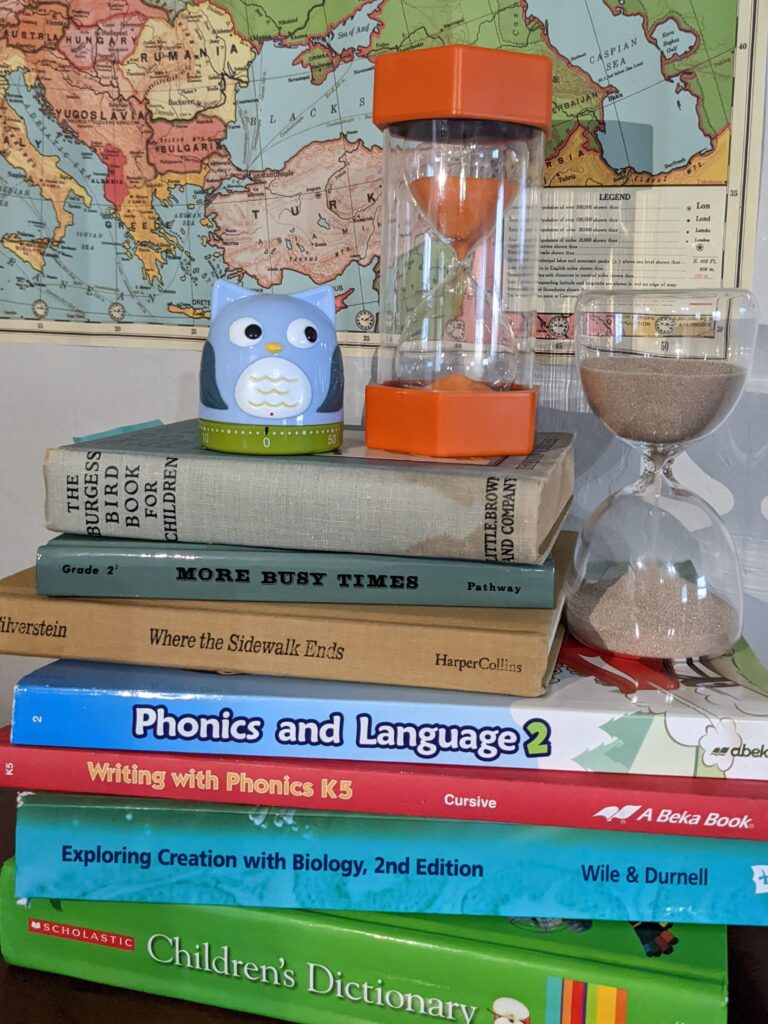

Short sprint timers / individual timers:
There are 2 types of these timers that we use: ticking and silent.
These keep you focused on the task. They have a hard stop and encouragement to keep going.
Ticking – The quiet ticking noise reminds the student to stay focused.
My daughter Lara says “The timer keeps me from getting distracted and helps me go faster on my work.” This wasn’t always true. She had to train herself to focus and not get stressed out. When we first used the ticking timer she would get nervous and could not get her work done. But, after some practice, she learned not to worry about it and to use it as a gentle reminder to keep working.
This is also known as the Pomodoro Timer and Technique that knowledge workers use to stay focused.
- Subjects that work well for this type of timer are:
- math facts drills – This is my favorite free site for those: https://www.math-drills.com/
- handwriting pages – these are our current favorites: Zaner-Bloser Handwriting
- writing out spelling words
- tests and quizzes
- math lessons – staying focused during the lesson
- thinking skills handouts – we love these books: Building Thinking Skills
- Ticking Timers have worked for us:
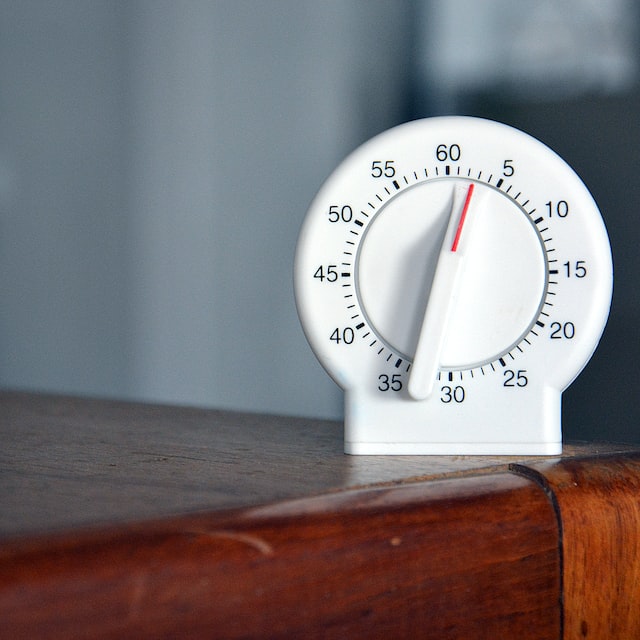
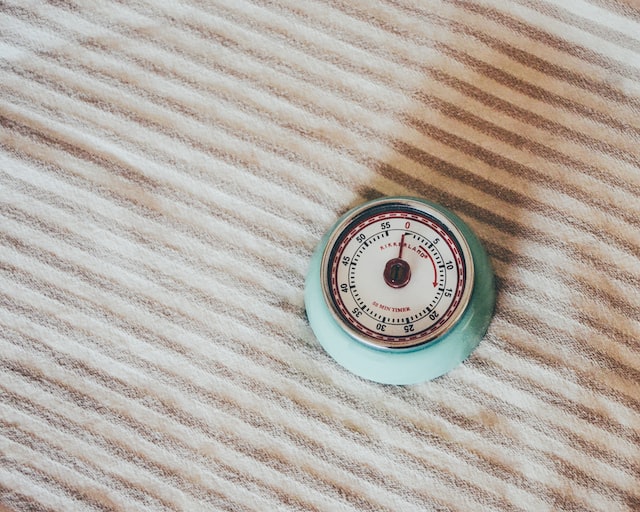
Silent – This timer is characterized by it’s short length (less than an hour) and beep or ding at the end of the chosen time. We use these to remind us to switch to the next activity.
- Subjects that work well for this type of timer are:
- assigned reading – 20 mins instead of a # of pages
- geography handouts – Evan-Moore Geography books
- history lessons with mom – Story of the World
- phonics lessons with mom – Abeka Handbook for Reading
- Science reports and creative writing at the computer – 20 minutes
- color pages for history lessons or science activity
- free time: Legos, gear toys, snap circuits, Pearler Beads, craft projects, Keva Blocks…
- special projects for each individual kid (Lara enjoys studying architecture)
- Silent Timers that have worked for us:
- We love these book timers (mark-my-time.com).
- Visual timers are very helpful to easily show how much time is left. Here are 2 that we use: Secura 60-Minute Visual Timer & TWENTY5 SEVEN Countdown Timer 7.5 inch; 60 Minute 1 Hour Visual Timer
- mooas Cube Timer on Amazon – this one has 4 Pre-set Times: 5, 10, 20, 30 min.
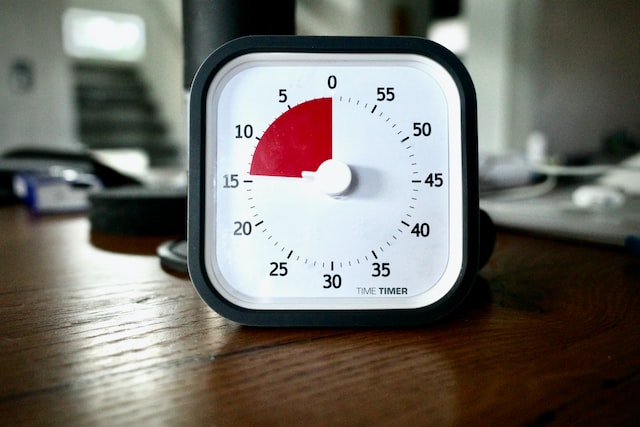
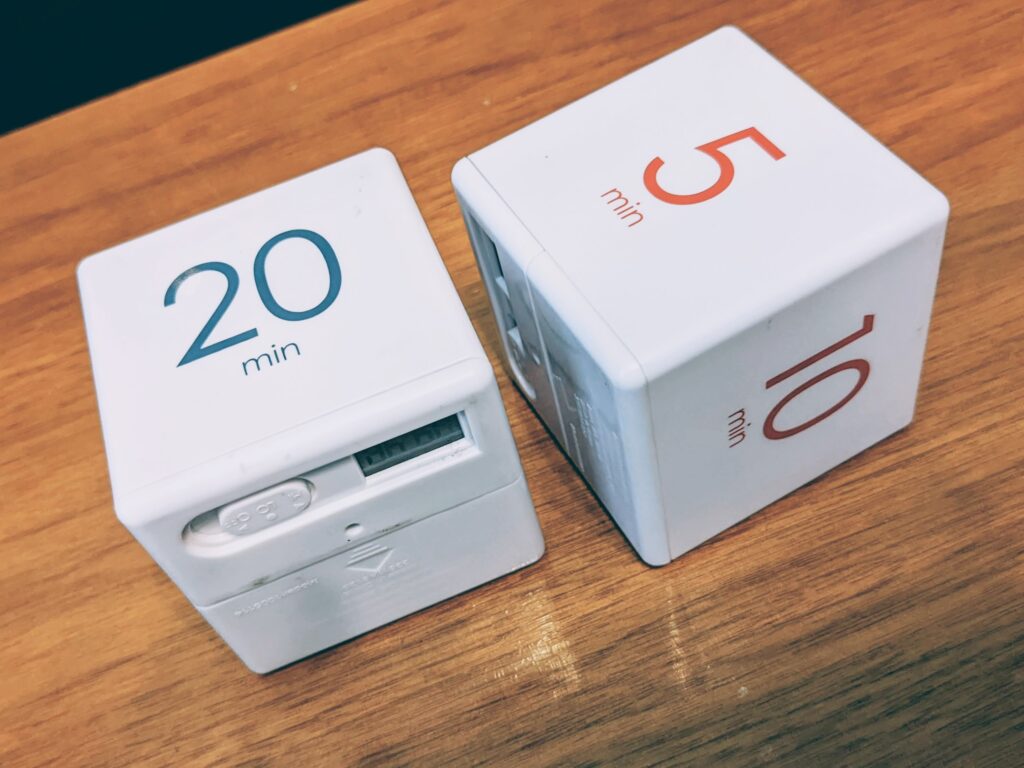
Questions for you:
– What do you use timers for?
– Do you expect your brain to remember all the routines or do you set alarms for your future self?
(see this article for more ideas: How to Be Kind to my Future Self)
– How could timers help your homeschool day?
– What can you do to slowly include timers in your daily routines?
– What areas can you include timers to increase productivity?
I got some helpful advice on using Homeschool Timers from my very productive and organized sister-in-law Michelle. She is a mom of four young kids, has been homeschooling for over 6 years, spends her weekends working nights as a head nurse at the NICU, and is my go-to resource for parenting advice. When I asked her about timers she had a lot of great things to say:
“My kids find timers a bit stressful. But I decided this past year it’s good to use them anyways. Cause time doesn’t care if you’re stressed, or not ready, or anything. Time keeps ticking. And the real world has deadlines. We don’t use them for everything, but I use them for math, and to help with transitions between activities. Timers help them know a transition is coming as it ticks down. So it helps give a visual to pick up the pace. It’s a gentle introduction to staying on task.”
“I also use timers for clean up. “Clean up the toys you want to keep” and then I set the timer and I go get a box. When the timer goes off I box up what is left out and they can earn it back later to put it away.”
“I find it helpful to call out intervals of time until they need to transition. “30 min until we hop off the computers” “20 min”, “10 min”, “5 min”. It’s helping them have a less stressful transition than the immediate cutoff… But requires effort on my part to remember. Also, follow-through is important, and something I’m working on. I have to follow through on the transition when the timer goes off. Otherwise, it’s useless and a waste of effort to set a timer if you won’t stick to it. So I am careful to be reasonable about how much time to set, and then stick to it.”
– Michelle Frolander

Timers have made a big difference in our homeschool.
We have found that our school time is easier to control and more productive. We can get more work done in a shorter amount of time with the encouragement and guidance of the timers.
My job is no longer to keep everyone on track and focused on school work. The timers are doing that job for me! I can do more teaching tasks and I don’t have to switch contexts so often. I am able to focus on the student in front of me and teach the lesson well. I am still in the room, in case they need help, but they are more independent.
I hope that this has been helpful for you. I would love to hear how timers are working in your homeschool day.
⌛⏲️Happy Homeschooling! – April
(with help from Lara and Michelle)
Photo by Oscar Nord and others on Unsplash